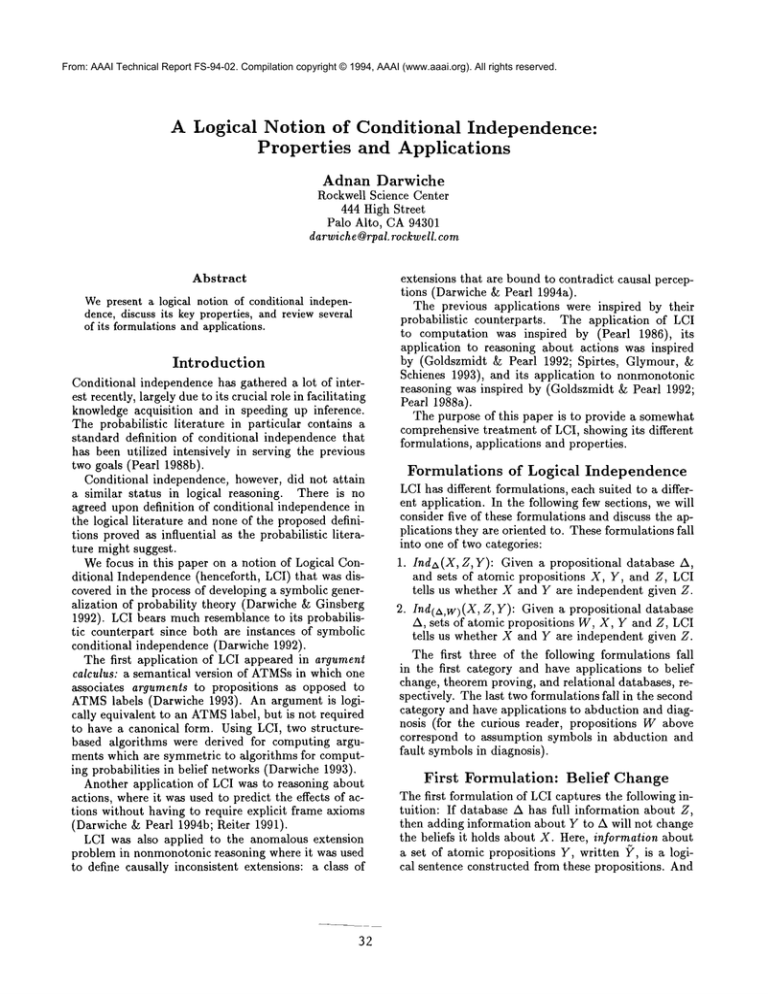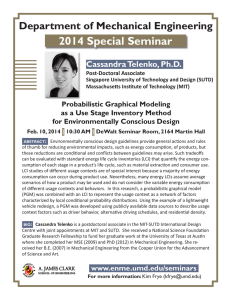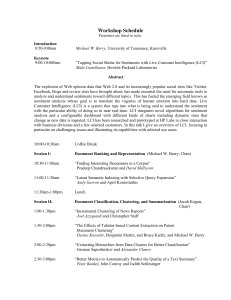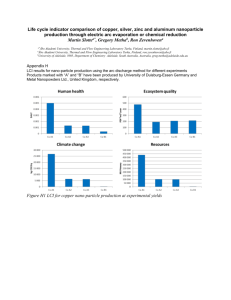
From: AAAI Technical Report FS-94-02. Compilation copyright © 1994, AAAI (www.aaai.org). All rights reserved.
A Logical
Notion of Conditional
Independence:
Properties and Applications
Adnan
Darwiche
Rockwell Science Center
444 High Street
Palo Alto, CA94301
darwiche@rpal.rockwell, corn
Abstract
Wepresent a logical notion of conditional independence, discuss its key properties, and review several
of its formulationsand applications.
Introduction
Conditional independence has gathered a lot of interest recently, largely due to its crucial role in facilitating
knowledge acquisition and in speeding up inference.
The probabilistic literature in particular contains a
standard definition of conditional independence that
has been utilized intensively in serving the previous
two goals (Pearl 1988b).
Conditional independence, however, did not attain
a similar status in logical reasoning. There is no
agreed upon definition of conditional independence in
the logical literature and none of the proposed definitions proved as influential as the probabilistic literature might suggest.
Wefocus in this paper on a notion of Logical Conditional Independence (henceforth, LCI) that was discovered in the process of developing a symbolic generalization of probability theory (Darwiche & Ginsberg
1992). LCI bears muchresemblance to its probabilistic counterpart since both are instances of symbolic
conditional independence (Darwiche 1992).
The first application of LCI appeared in argument
calculus: a semantical version of ATMSsin which one
associates arguments to propositions as opposed to
ATMSlabels (Darwiche 1993). An argument is logically equivalent to an ATMS
label, but is not required
to have a canonical form. Using LCI, two structurebased algorithms were derived for computing arguments which are symmetric to algorithms for computing probabilities in belief networks (Darwiche 1993).
Another application of LCI was to reasoning about
actions, where it was used to predict the effects of actions without having to require explicit frame axioms
(Darwiche & Pearl 1994b; Reiter 1991).
LCI was also applied to the anomalous extension
problem in nonmonotonic reasoning where it was used
to define causally inconsistent extensions: a class of
32
extensions that are bound to contradict causal perceptions (Darwiche & Pearl 1994a).
The previous applications were inspired by their
probabilistic
counterparts. The application of LCI
to computation was inspired by (Pearl 1986), its
application to reasoning about actions was inspired
by (Goldszmidt & Pearl 1992; Spirtes, Glymour,
Schienes 1993), and its application to nonmonotonic
reasoning was inspired by (Goldszmidt & Pearl 1992;
Pearl 1988a).
The purpose of this paper is to provide a somewhat
comprehensive treatment of LCI, showing its different
formulations, applications and properties.
Formulations
of Logical
Independence
LCI has different formulations, each suited to a different application. In the following few sections, we will
consider five of these formulations and discuss the applications they are oriented to. These formulations fall
into one of two categories:
1. IndA(X,Z,Y): Given a propositional
database A,
and sets of atomic propositions X, Y, and Z, LCI
tells us whether X and Y are independent given Z.
2. Ind(Aw)(X, Z,Y): Given a propositional database
A, sets of atomic propositions W, X, Y and Z, LCI
tells us whether X and Y are independent given Z.
The first three of the following formulations fall
in the first category and have applications to belief
change, theorem proving, and relational databases, respectively. The last two formulations fall in the second
category and have applications to abduction and diagnosis (for the curious reader, propositions Wabove
correspond to assumption symbols in abduction and
fault symbols in diagnosis).
First
Formulation:
Belief
Change
The first formulation of LCI captures the following intuition: If database A has full information about Z,
then adding information about Y to A will not change
the beliefs it holds about X. Here, information about
a set of atomic propositions Y, written Y, is a logical sentence constructed from these propositions. And
full information about a set of atomic propositions Z,
1written 2, is a conjunctive clause over atoms Z.
Theorem 1 IndA(X, Z, Y) iff
Definition 1 Let X, Y, and Z be disjoint sets of
atomic propositions. Database A finds X independent
of Y given Z, written Indz~(X,Z,Y), iff
for all disjunctive clauses X, ~z, 22
A U {2} ~ )f precisely
A ~ )(VYVZ precisely
When Z is empty (meaning that X and Y are
marginally independent), then 2 --- false, and we have
when A U {2, Y} ~ ff
A ~ ~ V Y precisely
for all fi, Y, 2 such that A U {2, Y} is consistent.
For example,
Database {it_rained V sprinkler_was_on = wet_ground)
finds {it_rained} independent of {sprinkler_was_on},
but finds them dependent given {wet_ground}.
Database {it_rained D wet_ground, wet_ground D
slippery_ground} finds {slippery_ground} dependent
on {it_rained}, but finds them independent given
{wet_ground}.
If a database is structured graphically, then one can
derive someconditional independences that it satisfies
from its graphical structure. Wewill discuss this in
more detail later, but let us first consider the structured databases depicted in Figure 1. The graph associated with each database can be used to identify
conditional independences that are satisfied by the
database. In particular,
whenever X and Y are dseparated by Z (Pearl 1988b), we have IndA(X, Z, Y).
For example:
when A ~ A" or A ~ ]~.
Using Theorem 1, one can derive structure-based
complexity results for satisfiability.
One representative result says that if the database is structured as
a tree, then satisfiability
is linear in the number of
propositions even though the resulting database may
3not be horn.
Third Formulation: Relational
Databases
This formulation of LCI shows its relation
ded multivalued dependencies in relational
(Pearl 1988b):
to embeddatabases
Theorem2 Indz~(X, Z, Y) iff the logical consistency
of A U {2, X} and of A U {2, Y} implies the logical
consistencyof exu{2,?, X}for art conjunctive clauses
2, Y and 2.
The main application of this formulation is in proving properties about LCI.
Inda({A}, {}, {B}) in Figure 1.1.
Inda({A}, {B}, {C}) in Figure 1.2.
IndA({B}, {A}, {C}) in Figure 1.3.
Fourth
Formulation:
Abduction
This formulation of LCI is best suited to abduction
and ATMSs(P~eiter ~ de Kleer 1987).
Similar to theorem proving, one difficulty with computing ATMSlabels is that it cannot be done compositionally. In particular, the ATMS
label of a disjunction
V/3 cannot be composed from the ATMSlabels of
the disjuncts c~ and ft. But if a and fl are independent,
then compositionality holds.
Wefirst need the notion of an argument to phrase
this formulation:
The major application of this formulation of LCI
has been to formalizing a class of nonmonotonic extensions, called causally inconsistent extensions (Darwiche& Pearl 1994a). The basic idea is that our perceptions of causal influences impose constraints on our
belief changes, which take the form "If I observe 7,
then observing/~ would not change my belief about a."
An extension is causally inconsistent if it supports belief changes that violate these constraints. The reader
is referred to (Darwiche &~Pearl 1994a) for more details on causal inconsistency.
Second Formulation:
when A ~ fiVZ or A ~ YVZ.
Definition 2 The argument for sentence c~ wrt to
database A and propositions W, written Arg(c~), is the
logically weakest sentence I~V such that 4AU{I~}~ o~.
Theorem Proving
The second formulation of LCI is oriented towards theorem proving (satisfiability).
The difficulty in theorem
proving (at least in the propositional case) stems from
the inability to do compositional proving. That is, although one can decompose the proving of a A/? into
the proving of c~ and the proving of/?, one cannot decomposethe proving of a V/3 into the proving of c~ or
the proving of j3. However,if a and j3 are independent,
then this decomposition is valid:
2Adisjunctive clause _~ is a disjunction of literals, one
for each atomic proposition in X.
3Confining oneself to horn clauses is a commontechnique for reducing the computationalcomplexityof satisfiability and is related to confiningoneself to tree structures.
Both restrictions are dealing with the sameproblem: proving disjunctions such as c~ v flI Confiningoneself to tree
structures ensures that c~ and fl are independentso that
proving (~ V f~ can be decomposedinto proving a and proving ft. The horn-clause restriction, however,eliminates the
needto prove disjunctions all together.
4Noproposition in Wcan appear in c~.
1Aconjunctive clause Z is a conjunctionof literals, one
for each atomic proposition in Z.
33
1
2
Q
A implies C
B implies C
A implies B
B implies C
A = rain
B = sprinkler was on
C= wet grass
A implies B
not A implies not C
A = rain
B = wet ground
C = slippery ground
Figure 1: Structured databases. Each graph identifies
A = battery ok
B = lights on
C = car starts
independences that are satisfied by the associated databases.
The argument for a is logically equivalent to its ATMS
label when Wis the set of assumption symbols (Darwiche 1993).
This formulation of LCI goes as follows:
a diagnosis for c~ A ft. But if a and fl are independent,
then this composition is valid.
Weneed the notion of a consequence to state this
formulation of LCI:
Definition 3 Let X, Y, Z and W be disjoint sets of
atomic propositions. The pair (A, W) finds X independent of Y given Z, written Ind(A,w)(X,Z,Y), iff
Definition 4 The consequence of sentence a wrt to
database A and propositions W, written Con(a), is the
logically strongest sentence 17V such that AU{a}~ I~.
5
Arg(X V Y V 2) =_ Arg(X V 2) V Arg(Y V Z),
The consequenceof a is logically equivalent to its kernel diagnosis whenWis the set of fault symbols (Darwiche 1993; de Kleer, Mackworth, & Reiter 1992).
This formulation of LCI goes as follows:
for all disjunctive clauses f(, ~z, 2.
This formulation of LCI was used elsewhere to derive
a structure-based algorithm for computing arguments
and ATMSlabels (Darwiche 1994).
Consider the database in Figure 2 where W =
{OK(X), OK(Y)}. The argument OK(Y) for -~A V
-~B V D cannot be composed from the argument false
for --A V D and the argument false for -~B V D. This
should not be surprising, however, since {A} and {B}
are not d-separated by {D}. But the argument OK(X)
for -~C V --A V -~D can be composed from the argument OK(X) for -~C V -~A and the argument false for
--D V --A since {C} and {D} are d-separated by {A}.
The connection between the LCI formulations Definitions 1 and 3 is as follows:
Theorem 3
Theorem 4 Ind(z~,w)(X,
Con(X
A? ^ 2) =__Con(2A2) ACon(?^ 2)
for all conjunctive clauses f~, Y and 2.
Consider the database in Figure 2 where W =
{OK(X), OK(Y)}. The consequence of C is true (C
is a normal behavior), the consequence of D is true (D
is a normal behavior), but the consequence of C A
is -,OK(X) V -,OK(Y) (C is anabnormal behavior). This shows that the diagnoses for C A D cannot
be composed from the diagnoses for C and those for
D, which is not surprising since {C} and {D} are not
d-separated in Figure 2.
This formulation of LCI was used elsewhere to derive a structure-based algorithm for computing consequences and diagnoses (Darwiche 1994).
Ind ( a,w) ( X, Z, Y) precisely whenInd z~ ( U W, Y ).
Fifth
Formulation:
Z, Y)
Diagnosis
The fifth formulation of LCI is best suited to diagnostic applications. Again, one difficulty with computing
diagnoses is that it cannot be done compositionally.
That is, if one observes a and fl about some system,
one cannot simply compute the diagnoses for each of
a and fl individually and then compose them to form
Properties
LCI satisfies
1988b):
of Logical
Independence
the well known graphoid axioms (Pearl
5No proposition
34
in W can appear in (~.
d-Separation
There is a topological test on directed acyclic graphs,
called d-separation, that tells us whether two sets of
nodes are d-separated by a third set (Pearl 1988b).
separation could be viewed as a relation Sep~ where
Sept(X, Z, Y) holds precisely when Z d-separates X
from Y in the directed acyclic graph G. The importance of d-separation stems from the following result
which follows from a theorem in (Verma 1986):
A & ok(X) => ~C
A &B & ok(Y)
-A & ok(X) => C ~(A & B) & ok(Y)
Theorem6 Let (A,G) be a structured database and
let Wbe the propositions appearing in A but not in ~.
If Z d-separates X from Y in ~, then A finds X and
Y independent given Z U W. That is, Sept(X, Z, Y)
implies IndA(X, Z U W, Y).
Figure 2: A structured database representing the functionality of a digital circuit.
1. Ind tx ( X, Z, Y) precisely whenInd A ( Y, Z, X)
2. IndA(X,Z,Y)
and Indzx(X,Z
when Indzx (X, Z, Y U W).
U Y,W) precisely
These axioms are proved in (Darwiche 1992) using the
LCI formulation given in Definition 3.
The graphoid axioms are important for at least two
reasons. First, they are intuitive properties that independence is expected to satisfy (Pearl 1988b). Second,
they lead to a very important result about databases
that are structured around the topology of a directed
acyclic graph.
Structured
Databases
A structured database is a pair (A, G): ~ is a directed
acyclic graph where nodes represent atomic propositions and A is a set of micro theories. Each micro
theory corresponds to one proposition n in G and contains material implications of the form /V A I~ D ft.
Here, N are the parents of n, Ware propositions that
do not appear in G, and if o~ D n and fl D ~n appear in the micro theory for n, then cr A/3 must be
inconsistent. Figures 1 and 2 depict a few structured
databases. More details on structured database can be
found in (Darwiche & Pearl 1994a).
Structured databases satisfy a property that (together with the graphoid axioms) leads to a class of
structured-based algorithms for satisfiability,
abduction and diagnosis (Darwiche & Pearl 1994a):
Theorem 5 Let (A,G) be a structured database, W
be atomic propositions that appear in A but not in G,
n be a node in G, Z be its parents, and Y be its nondescendants. Then Inda({n}, Z U W,Y).
That is, each proposition is independent of its nondescendants given (1) its parents and (2) propositions
that do not appear in the graph.
35
d-separation allows one to infer many of the independences in a structured database by examining the
topology of its graph. These independences can guide
algorithms in decomposing complex computations into
simpler ones than can be performed in parallel. Suppose for example that we want to test whether a V fl
is entailed by some structured database (A,G). If
shows ~ and/3 to be independent, then we can reduce
this test into two simpler tests: whether a is entailed
by A and whether fl is entailed by A.
But even if a and/3 are dependent, we can find some
7t and 72 such that aVfl is equivalent to (aVflVT1)A
(aV/3V72) and such that a and/3 are independent given
either 71 or 72. Wecan then decompose the proving
of a V fl into the proving of a V 71, fl V 72, c~ V 72 and
fl V 72 using Theorem1. For the decomposition to be
useful, however, we want the latter proofs to be simpler
than the original one (that of proving a V ~). Finding
a good choice of 71 and 72 is therefore a crucial step
in structure-based algorithms. The details of some of
these algorithms can be found in (Darwiche 1994).
Improving
d-Separation
Structure-based algorithms utilize independences that
are derived from the dag of a structured database.
There are, however, independences that hold in the
database but are not reflected in its associated dag.
Therefore, dags are not rich enough to capture all the
independences satisfied by a database and we need
more refined graphical structures for this purpose.
To illustrate this point, consider the two structured
databases in Figure 3. In the first one, {A} and {C}
are independent although they are not d-separated.
And in the second, {B} and {C} are also independent although not d-separated. Intuitively, in the first
database, there is no information about A that could
lead us to prove anything about C. Similarly in the
second database, neither B nor -~B will help in proving
anything about C.
These observations represent the first step in a developing a topological test that is stronger than dseparation but that also requires a graphical structure
A implies B
not B implies C
A implies
B A implies
C
Figure 3: Structured databases satisfying more independences than is revealed by their graphical structures.
that is richer than a dag. In particular, such a structure should distinguish between the path A ~ B ---* C
in Figure 1.2 and the same path in Figure 3.1 since the
former permits logical influences to be passed between
A and C but the latter path does not. More refined
structures for capturing more independences are the
subject of current research.
Conclusion
Wehave proposed a precise notion of conditional independence with respect to propositional databases. We
provided several equivalent formulations of the notion
oriented towards different applications, including satisfiability,
abduction and diagnosis. Weshowed that
if databases are structured graphically, then many of
the independences they satisfy can be read off their
underlying graphical structures. Wealso showed that
day structures are not rich enough to capture all the
independences satisfied by a database and there is a
need for adopting more refined structures.
References
Darwiche, A., and Ginsberg, M. L. 1992. A symbolic
generalization of probability theory. In Proceedings
of the Tenth National Conference on Artificial Intelligence (AAAI), 622-627.
Darwiche, A., and Pearl, J. 1994a. Symbolic causal
networks. In Proceedings of AAAI, 238-244. AAAI.
Darwiche, A., and Pearl, J. 1994b. Symbolic
causal networks for reasoning about actions and
plans. Working notes: AAAISpring Symposium on
Decision-Theoretic Planning.
Darwiche, A. 1992. A Symbolic Generalization of
Probability Theory. Ph.D. Dissertation, Stanford University.
Darwiche, A. 1993. Argument calculus and networks.
In Proceedings of the Ninth Conference on Uncertainty in Artificial Intelligence (UAI), 420-427.
Darwiche, A. 1994. Conditional independence in
ATMSs:Independence-based algorithms for comput-
36
ing labels and diagnoses. In Proceedings of the Fifth
International Workshop on Principles of Diagnosis,
(to appear).
de Kleer, J.; Mackworth, A. K.; and Reiter, R. 1992.
Characterizing diagnoses and systems. Artificial Intelligence 56(2-3):197-222.
Goldszmidt, M., and Pearl, J. 1992. Rank-based
systems: A simple approach to belief revision, belief
update and reasoning about evidence and actions. In
Proceedings of the Third Conference on Principles of
Knowledge Representation and Reasoning, 661-672.
Morgan KaufmannPublishers, Inc., San Mateo, California.
Pearl, J. 1986. Fusion, propagation and structuring in
belief networks. Artificial Intelligence 29(3):241-288.
Pearl, J. 1988a. Embracingcausality in default reasoning. Artificial Intelligence 35:259-271.
Pearl, J. 1988b. Probabilistic Reasoningin Intelligent
Systems: Networks of Plausible Inference. Morgan
KaufmannPublishers, Inc., San Mateo, California.
Reiter, R., and de Kleer, J. 1987. Foundations of
assumption-based truth maintenance systems: Preliminary report. In Proceedings of AAAI, 183-188.
AAAI.
Reiter, R. 1991. The frame problem in the situation
calculus: A simple solution (sometimes) and a completeness result for goal regression. In Lifschitz, V.,
ed., Artificial Intelligence and Mathematical Theory
of Computation: Papers in Honor of John McCarthy.
Academic Press, San Diego, Ca. 359-380.
Spirtes, P.; Glymour, C.; and Schienes, R. 1993. Causation, Prediction, and Search. NewYork: SpringerVerlag.
Verma, T. S. 1986. Causal networks: Semantic and
expressiveness.
Technical Report R-65, Cognetive
Systems Laboratory, UCLA.






